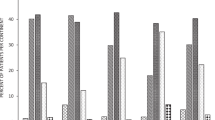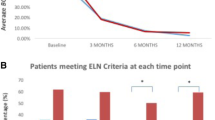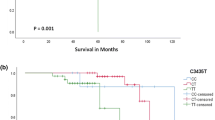Abstract
The distribution of BCR–ABL1 transcript variants e13a2 (“b2a2”) and e14a2 (“b3a2”) in Nigerians with chronic myeloid leukemia (CML) had not been previously studied. In addition, there is paucity of data on the impact of BCR–ABL1 transcript variants on clinical presentation and survival in CML patients in Nigeria. The BCR–ABL1 transcript variants were analyzed in 230 Imatinib-treated CML patients at diagnosis. Patients with incomplete data (n = 28), e19a2 (n = 3) and e1a2 (n = 1) were excluded from analysis of transcript variant on disease presentation and survival leaving only 198. The frequencies of BCR–ABL1 transcript variants were 30 (13.0%), 114 (49.6%), 82 (35.7%), three (1.3%) and one (0.4%) for e13a2, e14a2, co-expression of e13a2/e14a2, e19a2 and e1a2, respectively. A significantly higher platelet count was found in patients with e13a2 variant (531.1 ± 563.4 × 109/L) than in those expressing e14a2 (488.2 ± 560.3 × 109/L) or e13a2/e14a2 (320.7 ± 215.8 × 109/L); p = 0.03. No significant differences were found between the variants with regards to gender, age, phase of disease at diagnosis, total white blood cell count, neutrophil percentage, hematocrit, splenomegaly or hepatomegaly. Overall survival was higher but not statistically significant (p = 0.4) in patients with e14a2 variant (134 months) than in e13a2 (119 months) and co-expression of e13a2/e14a2 (115 months). Nigerian CML patients have the highest incidence of co-expression of e13a2 and e14a2. Distinct disease characteristics which contrast with findings from the Western countries were also identified in Nigerians which may be due to genetic factors.




Similar content being viewed by others
References
Quintas-Cardama A, Cortes J (2009) Molecular biology of BCR–ABL1-positive chronic myeloid leukemia. Blood 113(8):1619–1630. https://doi.org/10.1182/blood-2008-03-144790
Jabbour E, Kantarjian H (2016) Chronic myeloid leukemia: 2016 update on diagnosis, therapy, and monitoring. Am J Hematol 91(2):252–265. https://doi.org/10.1002/ajh.24275
Onida F, Ball G, Kantarjian HM, Smith TL, Glassman A, Albitar M et al (2002) Characteristics and outcome of patients with Philadelphia chromosome negative, BCR/ABL negative chronic myelogenous leukemia. Cancer 95(8):1673–1684. https://doi.org/10.1002/cncr.10832
Kang ZJ, Liu YF, Xu LZ, Long ZJ, Huang D, Yang Y et al (2016) The Philadelphia chromosome in leukemogenesis. Chin J Cancer 35:48. https://doi.org/10.1186/s40880-016-0108-0
Goh HG, Hwang JY, Kim SH, Lee YH, Kim YL, Kim DW (2006) Comprehensive analysis of BCR–ABL transcript types in Korean CML patients using a newly developed multiplex RT-PCR. Transl Res 148(5):249–256. https://doi.org/10.1016/j.trsl.2006.07.002
Jain P, Kantarjian H, Patel KP, Gonzalez GN, Luthra R, Kanagal Shamanna R et al (2016) Impact of BCR–ABL transcript type on outcome in patients with chronic-phase CML treated with tyrosine kinase inhibitors. Blood 127(10):1269–1275. https://doi.org/10.1182/blood-2015-10-674242
Hanfstein B, Lauseker M, Hehlmann R, Saussele S, Erben P, Dietz C et al (2014) Distinct characteristics of e13a2 versus e14a2 BCR–ABL1 driven chronic myeloid leukemia under first-line therapy with imatinib. Haematologica 99(9):1441–1447. https://doi.org/10.3324/haematol.2013.096537
Baccarani M, Castagnetti F, Gugliotta G, Rosti G, Soverini S, Albeer A et al (2019) The proportion of different BCR–ABL1 transcript types in chronic myeloid leukemia. An international overview. Leukemia 33(5):1173–1183. https://doi.org/10.1038/s41375-018-0341-4
Gong Z, Medeiros LJ, Cortes JE, Zheng L, Khoury JD, Wang W et al (2017) Clinical and prognostic significance of e1a2 BCR–ABL1 transcript subtype in chronic myeloid leukemia. Blood Cancer J 7(7):e583. https://doi.org/10.1038/bcj.2017.62
Farhat-Maghribi S, Habbal W, Monem F (2016) Frequency of BCR–ABL transcript types in syrian CML patients. J Oncol 2016:8420853. https://doi.org/10.1155/2016/8420853
Hai A, Kizilbash NA, Zaidi SHH, Alruwaili J, Shahzad K (2014) Differences in structural elements of BCR–ABL oncoprotein isoforms in chronic myelogenous leukemia. Bioinformation 10:108–114. https://doi.org/10.6026/97320630010108
O'Brien SG, Guilhot F, Larson RA, Gathmann I, Baccarani M, Cervantes F et al (2003) Imatinib compared with interferon and low-dose cytarabine for newly diagnosed chronic-phase chronic myeloid leukemia. N Engl J Med 348(11):994–1004. https://doi.org/10.1056/NEJMoa022457
Vieira-Mion AL, Pereira NF, Funke VAM, Pasquini R (2017) Molecular response to imatinib mesylate of Brazilian patients with chronic myeloid leukemia. Rev Bras Hematol Hemoter 39(3):210–215. https://doi.org/10.1016/j.bjhh.2017.04.007
Milojkovic D, Apperley J (2009) Mechanisms of resistance to imatinib and second-generation tyrosine inhibitors in chronic myeloid leukemia. Clin Cancer Res 15(24):7519. https://doi.org/10.1158/1078-0432.CCR-09-1068
Bitencourt R, Zalcberg I, Louro ID (2011) Imatinib resistance: a review of alternative inhibitors in chronic myeloid leukemia. Rev Bras Hematol Hemoter 33(6):470–475. https://doi.org/10.5581/1516-8484.20110124
Castagnetti F, Gugliotta G, Breccia M, Iurlo A, Levato L, Albano F et al (2017) The BCR–ABL1 transcript type influences response and outcome in Philadelphia chromosome-positive chronic myeloid leukemia patients treated frontline with imatinib. Am J Hematol 92(8):797–805. https://doi.org/10.1002/ajh.24774
de Almeida Filho TP, Maia Filho PA, Barbosa MC, Dutra LLA, de Castro MF, Duarte FB et al (2019) Does BCR–ABL transcript type influence the prognosis of patients in chronic myelogenous leukemia chronic phase? Hematol Transfus Cell Ther 41(2):114–118. https://doi.org/10.1016/j.htct.2018.10.003
Oyekunle AA, Durosinmi MA, Bolarinwa RA, Owojuyigbe T, Salawu L, Akinola NO (2016) Chronic myeloid leukemia in Nigerian patients: anemia is an independent predictor of overall survival. Clin Med Insights Blood Disord 9:9–13. https://doi.org/10.4137/cmbd.s31562
D'Adda M, Farina M, Schieppati F, Borlenghi E, Bottelli C, Cerqui E et al (2019) The e13a2 BCR–ABL transcript negatively affects sustained deep molecular response and the achievement of treatment-free remission in patients with chronic myeloid leukemia who receive tyrosine kinase inhibitors. Cancer 125(10):1674–1682. https://doi.org/10.1002/cncr.31977
Anand MS, Varma N, Varma S, Rana KS, Malhotra P (2012) Cytogenetic & molecular analyses in adult chronic myelogenous leukaemia patients in North India. Indian J Med Res 135(1):42–48. https://doi.org/10.4103/0971-5916.93423
Mondal BC, Bandyopadhyay A, Majumdar S, Mukhopadhyay A, Chandra S, Chaudhuri U et al (2006) Molecular profiling of chronic myeloid leukemia in eastern India. Am J Hematol 81(11):845–849. https://doi.org/10.1002/ajh.20682
Muddathir AM, Kordofani AA, Fadl-Elmula IM (2013) Frequency of BCR–ABL fusion transcripts in Sudanese patients with chronic myeloid leukemia using real-time reverse transcription-polymerase chain reaction. Saudi Med J 34(1):29–33
Langabeer SE, McCarron SL, Kelly J, Krawczyk J, McPherson S, Perera K et al (2012) Chronic myeloid leukemia with e19a2 BCR–ABL1 transcripts and marked thrombocytosis: the role of molecular monitoring. Case Rep Hematol 2012:458716. https://doi.org/10.1155/2012/458716
Ikeda K, Harada-Shirado K, Matsumoto H, Noji H, Ogawa K, Takeishi Y (2014) Molecular response of e19a2 BCR–ABL1 chronic myeloid leukemia with double Philadelphia chromosome to dasatinib. J Clin Oncol 34(14):e130–e133. https://doi.org/10.1200/JCO.2013.51.1188
Qin YZ, Jiang Q, Jiang H, Lai YY, Shi HX, Chen WM et al (2018) Prevalence and outcomes of uncommon BCR–ABL1 fusion transcripts in patients with chronic myeloid leukaemia: data from a single centre. Br J Haematol 182(5):693–700. https://doi.org/10.1111/bjh.15453
Khazaal MS, Hamdan FB, Al-Mayah QS (2019) Association of BCR/ABL transcript variants with different blood parameters and demographic features in Iraqi chronic myeloid leukemia patients. Mol Genet Genom Med 7(8):e809. https://doi.org/10.1002/mgg3.809
Vasconcelos A, Azevedo I, Melo F, Neves W, Azevedo A, Melo R (2017) BCR–ABL1 transcript types showed distinct laboratory characteristics in patients with chronic myeloid leukemia. Genet Mol Res 16(2):gmr16029541. https://doi.org/10.4238/gmr16029541
Al-Achkar W, Moassass F, Youssef N, Wafa A (2016) Correlation of p210 BCR–ABL transcript variants with clinical, parameters and disease outcome in 45 chronic myeloid leukemia patients. J BUON 21(2):444–449
Acknowledgements
The authors acknowledge Novartis Pharmaceuticals and Max Foundation for their collaboration in making Imatinib (Glivec®) available to Nigerians with chronic myeloid leukemia, free-of charge. We also acknowledge the patients, resident doctors and nurses at the department of Haematology, OAUTHC, Ile-Ife.
Author information
Authors and Affiliations
Contributions
Study conception and design were performed by MAD Material preparation, data collection and analysis were performed by MAD and TOO. The first draft of the manuscript was written by TOO. All authors commented on previous versions of the manuscript. All authors read and approved the final manuscript.
Corresponding author
Ethics declarations
Conflict of interest
The authors declare that they have no conflict of interest.
Human and Animals Rights
The study was approved by the institutional ethics committee (Ethics and Research Committee, OAUTHC) and was performed in accordance with the ethical standards as laid down in the 1964 Helsinki declaration and its later amendments or comparable ethical standards. This article does not contain any studies with animals performed by any of the authors.
Informed Consent
Informed consent was obtained from all individual participants included in this study.
Additional information
Publisher's Note
Springer Nature remains neutral with regard to jurisdictional claims in published maps and institutional affiliations.
Rights and permissions
About this article
Cite this article
Owojuyigbe, T.O., Durosinmi, M.A., Bolarinwa, R.A.A. et al. Distribution of BCR–ABL1 Transcript Variants in Nigerians with Chronic Myeloid Leukemia. Indian J Hematol Blood Transfus 36, 646–651 (2020). https://doi.org/10.1007/s12288-020-01264-1
Received:
Accepted:
Published:
Issue Date:
DOI: https://doi.org/10.1007/s12288-020-01264-1




